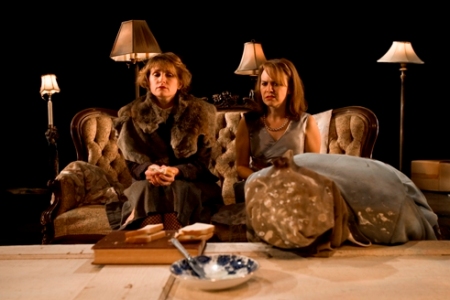Hamlet Goes it Alone at the Classical Theatre Company

Guy Robertson in One Man Hamlet
Photo by Anthony Robins
Houston's Classical Theatre Company aims to expand your idea of the classics. With The Merchant of Venice performed by prisoners in a concentration camp, and an Antigone that explored the rule of law as rule of religion, the troupe defines itself by shaking up a treasured genre. Next up is its One Man Hamlet, adapted and performed by Guy Roberts. John Johnston, Classical Theatre's artistic director, founder and co-director of One Man Hamlet clues us in.
29-95. What is the Classic Theatre Company's mission?
John Johnston: Our motto is boldly re-envisioning classical drama.
29-95: What defines theater as classical?
JJ: Anything 100 years old or older.
29-95: And your approach?
JJ: We are not putting the classics on display. We try to create a personal experience for the audience. We also play in small, intimate spaces.
29-95: How did you come upon One Man Hamlet?
JJ: It's a piece adapted and performed by Guy Roberts, artistic director of the Prague Shakespeare Festival. He's from Houston, and was here for the Houston Shakespeare Festival. He kindly agreed to stay and do this show. It's his baby. He also did it in Prague.
29-95: I can see how the concept makes sense. Hamlet has to be the most it's all about me character in the history of theater. He's the poster boy for narcissism. I wonder why Shakespeare didn't get the one-man idea. Where do we find your moody prince?
JJ: In an insane asylum under observation.
29-95: Shrinks love to weigh on Hamlet's particular brand of mental illness, and everyone loves a literary nut, so I can see that choice. Yet, it's a curious point of view, because it's Hamlet who sleuths about, over-observing everyone else.
JJ: Absolutely. He knows he is performing for an observing group of doctors. In a lot of ways Hamlet is a play about being observed and observing others. For example, the character Polonius is constantly spying on Hamlet (which in the end gets him killed), and Hamlet himself sets up The Mousetrap Scene to observe his murderous uncle's actions. In this adaptation of the play, we amplify the observation. Hamlet is under a microscope, and his actions and reactions and interactions are at the forefront of our conceit.
29-95: Isn't Hamlet already a one-man play of sorts?
JJ: Hamlet is a play about a character who is indeed totally alone. Even his closest friends are kept at arm's length (and some sent to their deaths). The only character that Hamlet trusts and confides in truly is the audience. Hamlet is a loner, and at risk of exploiting an overused term: a maverick. It is no coincidence that this play has so frequently been converted into a one-man adaptation. It just lends itself in that direction.
29-95: How ever does one man accomplish Ophelia's scenes?
JJ: By the blessed fact that Guy possesses extraordinary abilities. He weaves back and forth between different characters. He also has some basic props like a cot, a sink and some industrial chairs. With that we are able to create Hamlet's world.
29-95: Are you messing around with time?
JJ: No, not really. The feeling is contemporary, but there aren't any period references; Hamlet doesn't have an iPod.
29-95: Glad to hear that. I think we have all seen enough of Shakespeare roaming about history. There's still the problem of the mounting body count in the show. How does Roberts deal with that?
JJ: Hamlet, the patient, is obsessed with words, so that he constantly writing words all over the stage. When a character is killed he writes their name on the floor.
Classical Theatre Company presents One Man Hamlet, adapted and performed by Guy Roberts, based on the play by William Shakespeare, directed by Guy Roberts and John Johnston. October 8-18 at HITS Theatre, 311 West 18th Street. $15; $7 for students and seniors.
Reprinted from 29-95.com.





